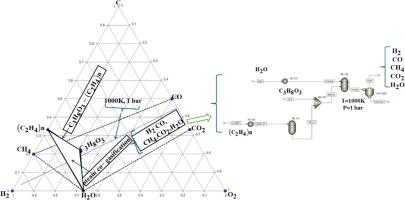甘油和线性低密度聚乙烯(LLDPE)共气化生产合成气:热力学目标方法
IF 6.7
1区 工程技术
Q2 ENERGY & FUELS
引用次数: 0
摘要
不同废物共气化生产合成气是一项很有前景的技术,因为它可以减轻废物管理的压力,促进废物的价值化。本文研究了甘油和线性低密度聚乙烯塑料(LLDPE)废料的蒸汽共气化生产合成气。为此,采用了基于碳、氢、氧(CHO)三元图的图形定位方法,以确定不同操作参数(压力、温度和 LLDPE 含量)对合成气成分的影响。结果表明,压力增加会降低 H2 和 CO 的含量,但会增加 CH4、CO2 和 H2O 的含量。同时还确定,增加 LLDPE 含量会增加 H2 和 CH4 的浓度,但会降低 CO、CO2 和 H2O 的浓度。此外,还确定了原料对合成气比率和较低热值(LHV)的协同作用。结果显示,增加压力会降低协同效应。此外,还在不同的蒸汽与原料比(SFR)以及 1000 K 和 1 bar 的条件下进行了 Aspen Plus 模拟。在 LLDPE 含量为 50%、SFR 分别为 0.8、1、0.8 和 0.8 时,协同效应的积极程度最高,LHV、合成气产量 (SY)、碳转化效率 (CCE) 和冷气效率 (CGE) 分别为 8.29 %、21.51 %、23.38 % 和 23.81 %。在这些操作条件下,LHV、SY、CCE 和 CGE 值分别为 11.63 MJ/Nm3、3.22 Nm3/kg、95 % 和 64 %。本文章由计算机程序翻译,如有差异,请以英文原文为准。

Co-gasification of glycerol and linear low density polyethylene (LLDPE) for syngas production: A thermodynamic targeting approach
The co-gasification of different wastes for syngas production is a promising technology as it reduces pressure on waste management and promotes waste valorization. This paper considered the steam co-gasification of glycerol and linear low density polyethylene plastic (LLDPE) waste to produce syngas. To achieve this, a graphical targeting approach based on carbon, hydrogen, oxygen (CHO) ternary diagrams was used to determine the impact of different operating parameters (pressure, temperature and LLDPE content) on syngas composition. It was determined that an increase in pressure decreased H2 and CO content but increased the content of CH4, CO2 and H2O. It was also determined that increasing the LLDPE content increased H2 and CH4 concentration, but decreased CO, CO2 and H2O concentration. The synergistic interaction of the feedstocks on the syngas ratio and lower heating value (LHV) was also determined. Results revealed that increasing the pressure decreased the synergistic effect. Furthermore, an Aspen Plus simulation was performed at different steam to feedstock ratios (SFR) and at 1000 K and 1 bar. The highest positive extent of synergy in terms of LHV, syngas yield (SY), carbon conversion efficiency (CCE) and cold gas efficiency (CGE) of 8.29 %, 21.51 %, 23.38 % and 23.81 % was achieved at LLDPE content of 50 % and SFR of 0.8, 1, 0.8 and 0.8 respectively. At these operating conditions the value of LHV, SY, CCE and CGE was found to 11.63 MJ/Nm3, 3.22 Nm3/kg, 95 % and 64 % respectively.
求助全文
通过发布文献求助,成功后即可免费获取论文全文。
去求助
来源期刊

Fuel
工程技术-工程:化工
CiteScore
12.80
自引率
20.30%
发文量
3506
审稿时长
64 days
期刊介绍:
The exploration of energy sources remains a critical matter of study. For the past nine decades, fuel has consistently held the forefront in primary research efforts within the field of energy science. This area of investigation encompasses a wide range of subjects, with a particular emphasis on emerging concerns like environmental factors and pollution.
 求助内容:
求助内容: 应助结果提醒方式:
应助结果提醒方式:


